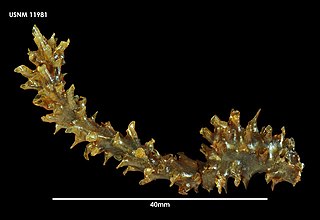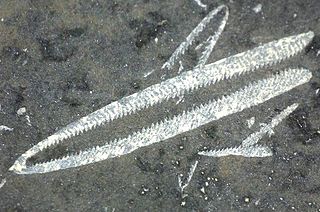Related Research Articles

Graptolites are a group of colonial animals, members of the subclass Graptolithina within the class Pterobranchia. These filter-feeding organisms are known chiefly from fossils found from the Middle Cambrian through the Lower Carboniferous (Mississippian). A possible early graptolite, Chaunograptus, is known from the Middle Cambrian. Recent analyses have favored the idea that the living pterobranch Rhabdopleura represents an extant graptolite which diverged from the rest of the group in the Cambrian.

Pterobranchia, members of which are often called pterobranchs, is a class of small worm-shaped animals. They belong to the Hemichordata, and live in secreted tubes on the ocean floor. Pterobranchia feed by filtering plankton out of the water with the help of cilia attached to tentacles. There are about 25 known living pterobranch species in three genera, which are Rhabdopleura, Cephalodiscus, and Atubaria. On the other hand, there are several hundred extinct genera, some of which date from the Cambrian Period.

Rhabdopleura is a genus of colonial sessile hemichordates belonging to the Pterobranchia class. As one of the oldest living genera with a fossil record dating back to the Middle Cambrian, it is also considered to be the only living genus of graptolites.

Monograptidae is an extinct family of graptolites of the order Graptoloidea. Monograptids have only one row of thecae per stipe, unlike the biserial graptolites which have two opposing rows of thecae per stipe.
Anisograptidae is an extinct family of graptolites. As the first planktic graptolites, they play a crucial role for understanding the transition of graptolites from ocean floor suspension feeders to ocean surface plankton during the early Ordovician.
Sigmagraptidae is an extinct family of graptolites.

Dichograptidae is an extinct family of graptolites. Fossils are found mostly from the Late Ordovician to the Early Devonian.
Tetragraptidae is an extinct family of graptolites from the Floian to Darriwilian epochs of the Ordovician Period.
Glossograptidae is an extinct family of graptolites.

Diplograptidae is an extinct family of graptolites.
Climacograptidae is an extinct family of graptolites.
Dicranograptidae is an extinct family of graptolites.
Normalograptidae is an extinct family of graptolites.
Retiolitidae is an extinct family of graptolites characterized by meshwork-like tubaria.
Dimorphograptidae is an extinct family of graptolites.
Acanthograptidae is an extinct family of graptolites.
Cysticamaridae is an extinct family of graptolites.
Dithecodendridae is an extinct family of graptolites.
Cyclograptidae is an extinct family of graptolites.
Axonophora is an extinct suborder of graptolites. It primarily consists of the biserial graptolites, and also includes the retiolitids and monograptids.
References
- ↑ Maletz, Jörg (2017). Graptolite Paleobiology. Wiley-Blackwell. ISBN 9781118515617.
- ↑ Maletz, Jörg (2014). "The classification of the Pterobranchia (Cephalodiscida and Graptolithina)". Bulletin of Geosciences. 89 (3): 477–540. doi: 10.3140/bull.geosci.1465 . ISSN 1214-1119.